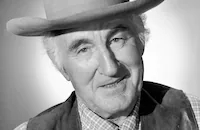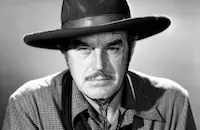The first MGM feature film to be made entirely in two-color Technicolor, The Viking (1928) was, strictly speaking, not truly an MGM film. It was indeed distributed by the studio, but it was financed and produced by the Technicolor Company in order to demonstrate the capabilities of their 2-color process. Technicolor president Herbert Kalmus functioned as the producer, with his wife Natalie serving as color art director. (Natalie Kalmus' name would become a fixture in the credits of Technicolor movies for decades to follow.) The overarching purpose of this film, which was relatively inexpensive to make, was to show off color and to get everyone wanting more of it -- audiences, film studios, theater owners.
In much the same way that modern movies sometimes sacrifice a coherent story for dazzling special effects, The Viking was so geared toward color that the script and direction were treated a bit shabbily. Based on a 1902 novel called The Thrall of Leif the Lucky, the story follows the adventures of Leif Ericsson and his crew of Vikings as they sail from Norway to what would later become Rhode Island. By all accounts, the film delves far more into fiction than into fact.
While critics all praised supporting actor Anders Randolph for his portrayal of Eric the Red, the silliness of the overall plot left many cold. Film Daily said: "Starts off with some good, meaty stuff such as a raid on an English castle by barbaric Vikings who kill and plunder, but then it goes sentimental, with the three principals all mooning over the same dame. Just a color novelty."
The New York Times noted sarcastically: "Most of the men appear to have had excellent razors and to have been most punctilious even on this auspicious voyage in indulging their fancy for a morning shave." The reviewer added, "This is a picture where lips are red, and when the hardy Vikings shed a little blood they let the red gore be seen on their blades." Even trade paper Variety was rather ho-hum about The Viking despite the presence of Technicolor: "The natural color thing is forgotten after awhile, excepting it does show how many different ways make-up on [actress] Pauline Starke may look."
Ultimately, The Viking was made to showcase the two-color process, and it remains a curiosity to this day for the same reason.
Leading man Donald Crisp was already a true veteran of the movie industry by 1928, having worked as actor, director or assistant director on legendary films like The Birth of a Nation (1915) and Broken Blossoms (1919). Well over half of his 173 acting credits would end up being in silent films. (The Viking was released as a silent with a Movietone score and sound effects.)
Director Roy William Neill would later go on to produce and direct most of the Sherlock Holmes films starring Basil Rathbone and Nigel Bruce. Neill had a close personal connection to ships and sailing: he'd been born off the coast of Ireland on a ship captained by his own father.
Producers: Herbert T. Kalmus
Director: R. William Neill
Screenplay: Jack Cunningham (writer); Ottilie A. Liljencrantz (novel "The Thrall of Leif the Lucky"); Randolph Bartlett (titles, uncredited)
Cinematography: George Cave
Art Direction: Carl Oscar Borg
Music: William Axt (uncredited)
Film Editing: Aubrey Scotto
Cast: Pauline Starke (Helga Nilsson), Donald Crisp (Leif Ericsson), LeRoy Mason (Lord Alwin), Anders Randolph (Eric the Red), Richard Alexander (Sigurd), Harry Lewis Woods (Egil the Black), Albert MacQuarrie (Kark), Roy Stewart (King Olaf), Torben Meyer (Odd), Claire McDowell (Lady Editha, Alwin's Mother).
BW-90m.
by Jeremy Arnold
The Viking

Brief Synopsis
Norse half-brothers vie for a throne and for the same woman.
Cast & Crew
Read More
R. William Neill
Director
Donald Crisp
Leif Ericsson
Pauline Starke
Helga
Leroy Mason
Alwin
Anders Randolph
Eric the Red
Richard Alexander
Siguard
Film Details
Genre
Adventure
Silent
Release Date
Nov
2,
1928
Premiere Information
not available
Production Company
Metro-Goldwyn-Mayer Pictures
Country
United States
Screenplay Information
Based on the novel The Thrall of Leif the Lucky; a Story of Viking Days by Ottilia Adelina Liljencrantz (Chicago, 1902).
Technical Specs
Duration
1h 30m
Sound
Silent (music score and sound effects)
Color
Color (2-strip Technicolor)
Film Length
8,394ft
(9 reels)

Synopsis
Leif Ericsson and his merry crew sail from Norway to what later came to be known as Rhode Island along a stream of wild adventures. Helga is the beauty of the group and attracts her share of constant admirers. An incident of attempted mutiny, several battle scenes, and Ericsson's climactic conversion to Christianity all contribute action to this "historic" tale.

Director
R. William Neill
Director
Cast

Donald Crisp
Leif Ericsson
Pauline Starke
Helga
Leroy Mason
Alwin
Anders Randolph
Eric the Red
Richard Alexander
Siguard

Harry Woods
Egil
Albert Macquarrie
Kark
Roy Stewart
King Olaf
Torben Meyer
Odd

Claire Mcdowell
Lady Editha
Julia Swayne Gordon
Thorhild
Crew

Videos
Movie Clip



Hosted Intro
Film Details
Genre
Adventure
Silent
Release Date
Nov
2,
1928
Premiere Information
not available
Production Company
Metro-Goldwyn-Mayer Pictures
Country
United States
Screenplay Information
Based on the novel The Thrall of Leif the Lucky; a Story of Viking Days by Ottilia Adelina Liljencrantz (Chicago, 1902).
Technical Specs
Duration
1h 30m
Sound
Silent (music score and sound effects)
Color
Color (2-strip Technicolor)
Film Length
8,394ft
(9 reels)

Articles
The Viking (1928)

The Viking (1928)
The first MGM feature film to be made entirely in two-color Technicolor, The Viking (1928) was, strictly speaking, not truly an MGM film. It was indeed distributed by the studio, but it was financed and produced by the Technicolor Company in order to demonstrate the capabilities of their 2-color process. Technicolor president Herbert Kalmus functioned as the producer, with his wife Natalie serving as color art director. (Natalie Kalmus' name would become a fixture in the credits of Technicolor movies for decades to follow.) The overarching purpose of this film, which was relatively inexpensive to make, was to show off color and to get everyone wanting more of it -- audiences, film studios, theater owners.
In much the same way that modern movies sometimes sacrifice a coherent story for dazzling special effects, The Viking was so geared toward color that the script and direction were treated a bit shabbily. Based on a 1902 novel called The Thrall of Leif the Lucky, the story follows the adventures of Leif Ericsson and his crew of Vikings as they sail from Norway to what would later become Rhode Island. By all accounts, the film delves far more into fiction than into fact.
While critics all praised supporting actor Anders Randolph for his portrayal of Eric the Red, the silliness of the overall plot left many cold. Film Daily said: "Starts off with some good, meaty stuff such as a raid on an English castle by barbaric Vikings who kill and plunder, but then it goes sentimental, with the three principals all mooning over the same dame. Just a color novelty."
The New York Times noted sarcastically: "Most of the men appear to have had excellent razors and to have been most punctilious even on this auspicious voyage in indulging their fancy for a morning shave." The reviewer added, "This is a picture where lips are red, and when the hardy Vikings shed a little blood they let the red gore be seen on their blades." Even trade paper Variety was rather ho-hum about The Viking despite the presence of Technicolor: "The natural color thing is forgotten after awhile, excepting it does show how many different ways make-up on [actress] Pauline Starke may look."
Ultimately, The Viking was made to showcase the two-color process, and it remains a curiosity to this day for the same reason.
Leading man Donald Crisp was already a true veteran of the movie industry by 1928, having worked as actor, director or assistant director on legendary films like The Birth of a Nation (1915) and Broken Blossoms (1919). Well over half of his 173 acting credits would end up being in silent films. (The Viking was released as a silent with a Movietone score and sound effects.)
Director Roy William Neill would later go on to produce and direct most of the Sherlock Holmes films starring Basil Rathbone and Nigel Bruce. Neill had a close personal connection to ships and sailing: he'd been born off the coast of Ireland on a ship captained by his own father.
Producers: Herbert T. Kalmus
Director: R. William Neill
Screenplay: Jack Cunningham (writer); Ottilie A. Liljencrantz (novel "The Thrall of Leif the Lucky"); Randolph Bartlett (titles, uncredited)
Cinematography: George Cave
Art Direction: Carl Oscar Borg
Music: William Axt (uncredited)
Film Editing: Aubrey Scotto
Cast: Pauline Starke (Helga Nilsson), Donald Crisp (Leif Ericsson), LeRoy Mason (Lord Alwin), Anders Randolph (Eric the Red), Richard Alexander (Sigurd), Harry Lewis Woods (Egil the Black), Albert MacQuarrie (Kark), Roy Stewart (King Olaf), Torben Meyer (Odd), Claire McDowell (Lady Editha, Alwin's Mother).
BW-90m.
by Jeremy Arnold














